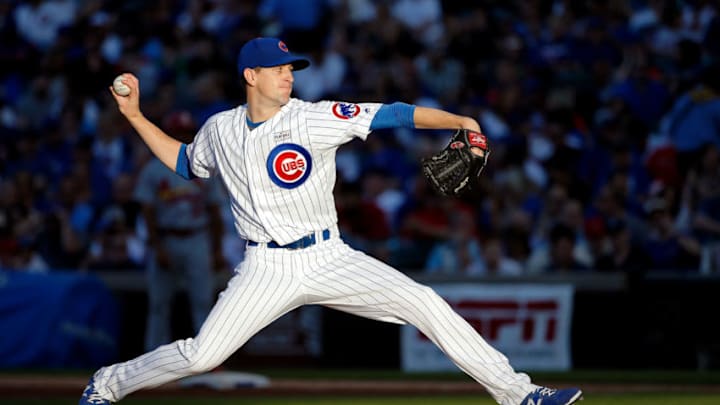At some point in the near future starting pitcher Kyle Hendricks will return to the mound for the Chicago Cubs. When that happens, will he pitch like he did last season?
As the Chicago Cubs begin to find their winning stride in the second half of the season, additional help may be on the way soon. Help, in the form of starting pitcher, Kyle Hendricks.
Hendricks has been out for a while now, dealing with tendinitis in his right hand. He last pitched a regular season game on June 4th, against the St. Louis Cardinals.
An encouraging sign for Cubs fans is that Hendricks has been making rehab starts in Double-A Tennessee. If all goes well, the Cubs could see Hendricks back in action with the big league club in no time.
When that happens, will Hendricks rediscover his 2016 form? The form that led to the right-hander leading the league in ERA.
More from Da Windy City
- Juan Soto appears headed to the Yankees which is not a big blow Chicago Cubs offseason
- 3 takeaways from Chicago Blackhawks shootout loss to Nashville
- Chicago Cubs in the middle of chaos that is Shohei Ohtani’s free agency
- The Chicago Cubs are on a roller coaster of emotions chasing Shohei Ohtani
- Chicago Bears quietly compiling list of head coaching candidates
Not known for having a lively heater, Hendricks relies heavily on a upper-80’s sinker, to go along with a changeup right around 80 mph. He’ll occasionally sprinkle in a low-to mid 70 mph curveball. All of which to induce weak contact from opposing hitters.
Too bad that scouting report, provided by fangraphs.com, was from a season ago. This season, up until his injury, Hendricks had been a different pitcher on the mound from the one fans saw in 2016.
The biggest problem facing Hendricks in 2017 has been a regression in pitch velocity. His sinker, changeup, and curveball are all being thrown a few ticks slower than in 2016.
Even though pitch velocity isn’t everything, it definitely can work in a pitcher’s favor at times. Velocity sometimes can make up for mistake pitches thrown over the heart of the plate.
While an 88 MPH fastball isn’t going to strike fear into a hitter, it’s still more beneficial to a Hendricks’ arsenal than disposing an 85 MPH fastball regularly.
Hendricks’ decline in pitch velocity, mainly his fastball, has made him more hittable to opposing batters this season. Batters this season are hitting .233 off him in 2017, compared to .207 last season.
In addition, because of the down-tick in fastball velocity, Hendricks has seen a regression in his control from a season ago. In just 61.2 innings pitched thus far, Hendricks has already walked 21 batters. He walked just 44 in 190 innings pitched last season.
It’s evident that Hendricks has lost some confidence in attacking hitters more often in the strike zone this season. Starters that don’t throw hard usually live and die through emphasizing precise pitch location.
For Hendricks, he knows he has to be even more careful about where to locate his pitches, now that his velocity is down. As a result, he has thrown more balls due to not wanting to give in to opposing hitters anywhere near the strike zone.
Related Story: Chicago Cubs must emphasize playing small ball
Hopefully, when he returns to the Cubs’ rotation, Hendricks will see an increase in pitch velocity. An uptick that has, to this point, eluded him.
If that happens, expect to see a return to form on the mound from the young right-hander. A return that sees his pedestrian 4.09 ERA shrink, with every passing start, from here on out.
